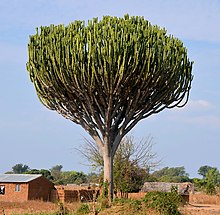| Euphorbia ingens | |
|---|---|

| |
|
Scientific classification
| |
| Kingdom: | Plantae |
| Clade: | Tracheophytes |
| Clade: | Angiosperms |
| Clade: | Eudicots |
| Clade: | Rosids |
| Order: | Malpighiales |
| Family: | Euphorbiaceae |
| Genus: | Euphorbia |
| Species: | E. ingens
|
| Binomial name | |
| Euphorbia ingens | |
| Synonyms [2] [3] | |
|
Euphorbia bilocularis N.E.Br. | |
Euphorbia ingens is a species of flowering plant in the family Euphorbiaceae. [2] It is native to dry areas of southern Africa. It is popularly known as the candelabra tree or naboom. Its milky latex can be extremely poisonous and is a dangerous irritant. [4]
Growth

This tall succulent tree with green round-like branches resembling a balloon is 6–8 meters tall. Its trunk is thick. Candelabrum stems have 5 ridges each and are 3.5–7.5 centimeters thick. Segmented sprouts are dark-green. Young sprouts have paired spines 0.5–2 millimeters long, often reflected. Small greenish yellow flowers sit on the ridges of the topmost segment. The plant blooms from autumn to winter. A red, round, three-lobed capsule fruit turns purple when ripe.
Habitat
The plant occurs in Malawi, Mozambique, Zimbabwe, Zambia, Botswana, Tanzania, South Africa (in the north and east of the country), Rwanda, Uganda, Kenya and Eswatini.
It grows on dry lands and semi-savannas. It prefers warm regions as it can survive long droughts. It usually roots on rocky outcrops or deep in sand among the bush.
Ecology
The plant’s flowers are attractive for butterflies, bees and other insects, which pollinate them when gathering pollen and nectar.
Seeds are edible for birds, who also like to make their nests in the branches of these trees. Woodpeckers in particular often use withered segments for this purpose.
Uses
The milky latex of the tree is extremely poisonous and can cause blindness, severe skin irritation and poisoning (when ingested) in humans and animals. However, this plant has been used medicinally as a purgative or for ulcers. Venda and Sotho people use it against cancer.
In South Africa and Zimbabwe candelabra tree stems are also used to poison fish.
Light and solid, the wood is used in door, plank, and boat production.
The candelabra tree is very adaptable and is grown in garden and rockery settings. The plant prefers sun and needs little water. It has few pests due to the toxic latex.
See also
References
- ^ Botanic Gardens Conservation International (BGCI).; IUCN SSC Global Tree Specialist Group (2019). "Euphorbia ingens". IUCN Red List of Threatened Species. 2019: e.T146212515A146212517. doi: 10.2305/IUCN.UK.2019-2.RLTS.T146212515A146212517.en. Retrieved 19 November 2021.
- ^ a b "Euphorbia ingens E.Mey. ex Boiss". Plants of the World Online. The Trustees of the Royal Botanic Gardens, Kew. n.d. Retrieved September 21, 2020.
- ^ "Plants Belonging to the Genus 'Euphorbia'". Archived from the original on 2016-10-24. Retrieved 2009-03-19.
- ^ "The Gods Must Be Crazy (movie)". H2G2.com. 14 January 2013. Retrieved 2013-10-17.
- "Euphorbia ingens". PlantZAfrica.com. Retrieved 2010-02-15.
